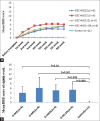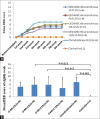Therapeutic Effect of Cell Transplantation and Chondroitinase in Rat Spinal Cord Injury
- PMID: 30598908
- PMCID: PMC6259289
- DOI: 10.4103/ijabmr.IJABMR_436_17
Therapeutic Effect of Cell Transplantation and Chondroitinase in Rat Spinal Cord Injury
Abstract
Background: Spinal cord injury (SCI) leads to permanent functional deficits because the central nervous system lacks the ability for spontaneous repair. Cell therapy strategies offered a hope in neurological repair. The clinical use of human embryonic stem cell transplantation is hampered by scientific and ethical controversies. Olfactory ensheathing cells (OECs)/bone marrow mesenchymal stem cell (MSC) is a promising cell source for autologous neurotransplantation devoid of ethical concerns.
Aim: This study aimed to evaluate the combined therapeutic effect of OEC, MSC, and chondroitinase in SCI rat models.
Materials and methods: Adult female albino Wistar rats were divided into ten groups, n = 6 rats in each group and control (n = 11). T10 level laminectomy was done in anesthetized rats to create drop-weight SCI. Both OEC and MSC were transplanted on the 9th day following SCI as a combined therapy with different dosage of 2 × 105, 5 × 105, 10 × 105, and >10 × 105 at a ratio of 1:1 with/without chondroitinase (0.2 U). One group of SCI rats was treated with chondroitinase alone 0.2 U. Dulbecco's Modified Eagle medium was injected in control rats. The outcome of transplantation was assessed using Basso, Beattie, Bresnahan (BBB) scale and motor-evoked potential studies.
Results: All the treated groups showed hindlimb motor recovery in BBB score except control group (P < 0.05). All the three combinations showed better results than OEC + MSC groups in hindlimb motor recovery. In dose-response relationship, 5- and 10-lakh combinations elicited increased functional recovery than 2- and more than 10-lakh combinations. However, chondroitinase alone demonstrated a highest BBB score than any other groups.
Conclusions: Chondroitinase/cell combinations have a therapeutic beneficial effect in SCI.
Keywords: Basso; Beattie; Bresnahan; chondroitinase; electromyography; mesenchymal stem cells; olfactory ensheathing cells; spinal cord injury; transplantation.
Conflict of interest statement
There are no conflicts of interest.
Figures






Similar articles
-
Functional Recovery Following the Transplantation of Olfactory Ensheathing Cells in Rat Spinal Cord Injury Model.Asian Spine J. 2018 Dec;12(6):998-1009. doi: 10.31616/asj.2018.12.6.998. Epub 2018 Oct 16. Asian Spine J. 2018. PMID: 30322257 Free PMC article.
-
Motor Recovery after Transplantation of Bone Marrow Mesenchymal Stem Cells in Rat Models of Spinal Cord Injury.Ann Neurosci. 2019 Jan;25(3):126-140. doi: 10.1159/000487069. Epub 2018 Apr 25. Ann Neurosci. 2019. PMID: 30814821 Free PMC article.
-
Minocycline Enhance the Restorative Ability of Olfactory Ensheathing Cells by the Upregulation of BDNF and GDNF Expression After Spinal Cord Injury.Basic Clin Neurosci. 2021 Nov-Dec;12(6):777-788. doi: 10.32598/bcn.2021.1727.1. Epub 2021 Nov 1. Basic Clin Neurosci. 2021. PMID: 35693138 Free PMC article.
-
Granulocyte colony-stimulating factor effects on neurological and motor function in animals with spinal cord injury: a systematic review and meta-analysis.Front Neurosci. 2023 Jun 28;17:1168764. doi: 10.3389/fnins.2023.1168764. eCollection 2023. Front Neurosci. 2023. PMID: 37449274 Free PMC article. Review.
-
Optimizing Olfactory Ensheathing Cell Transplantation for Spinal Cord Injury Repair.J Neurotrauma. 2020 Mar 1;37(5):817-829. doi: 10.1089/neu.2019.6939. J Neurotrauma. 2020. PMID: 32056492 Review.
Cited by
-
Mesenchymal Stem Cells Therapy Led to the Improvement of Spatial Memory in Rats with Alzheimer's disease Through Changing the Expression of LncRNA TUSC7/ miR-449a/ PPARγ and CD36 Genes in the Brain Tissue.Int J Mol Cell Med. 2023;12(2):108-119. doi: 10.22088/IJMCM.BUMS.12.2.108. Int J Mol Cell Med. 2023. PMID: 38313374 Free PMC article.
-
Regenerative Medicine: Pharmacological Considerations and Clinical Role in Pain Management.Curr Pain Headache Rep. 2022 Oct;26(10):751-765. doi: 10.1007/s11916-022-01078-y. Epub 2022 Sep 8. Curr Pain Headache Rep. 2022. PMID: 36074255 Free PMC article. Review.
-
Multi-target approaches to CNS repair: olfactory mucosa-derived cells and heparan sulfates.Nat Rev Neurol. 2020 Apr;16(4):229-240. doi: 10.1038/s41582-020-0311-0. Epub 2020 Feb 25. Nat Rev Neurol. 2020. PMID: 32099190 Review.
-
Reliable cell purification and determination of cell purity: crucial aspects of olfactory ensheathing cell transplantation for spinal cord repair.Neural Regen Res. 2020 Nov;15(11):2016-2026. doi: 10.4103/1673-5374.282218. Neural Regen Res. 2020. PMID: 32394949 Free PMC article. Review.
References
-
- Tuszynski MH, Gabriel K, Gage FH, Suhr S, Meyer S, Rosetti A, et al. Nerve growth factor delivery by gene transfer induces differential outgrowth of sensory, motor, and noradrenergic neurites after adult spinal cord injury. Exp Neurol. 1996;137:157–73. - PubMed
LinkOut - more resources
Full Text Sources
Research Materials

